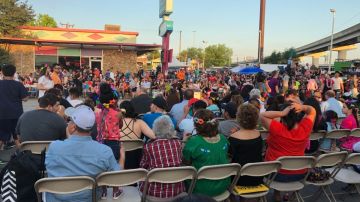I Visited San Antonio During Fiesta and Its History is More Important Than You Think
I was pretty excited when I learned I was going to go on a Chevy road trip from Austin to San Antonio this past weekend

Photo: Courtesy of Johanna Ferreira
I was pretty excited when I learned I was going to go on a Chevy road trip from Austin to San Antonio this past weekend. But what got me beyond ecstatic, was when I realized I was going to be out there with my boss right in the middle of Fiesta, San Antonio’s largest citywide celebration.
The parade/festival event this year ran from Thursday, April 19 to Monday April 30. It first started back in 1891 as a way to honor the memory of the heroes of the Alamo (originally known as the Misión San Antonio de Valero) and the Battle of San Jacinto. In case you’re not familiar, The Alamo was a mission that was founded in the 18th century by the Roman Catholic Church. It was part of the early Spanish missions in Texas that resulted in battle.
The battle of San Jacinto was fought on April 21, 1836, in what is considered today Harris Country, Texas and was essentially the battle of the Texas Revolution where the Texan army defeated General Antonio Lopez de Santa Anna’s Mexican army. Fiesta is a way San Antonians honor the fallen heroes that fought at the Alamo and San Jacinto. A large majority of the folks that attend are Mexicans, though there is a huge controversy within the Mexican community over whether or not they should be celebrating a festival that honors their European oppressors — that’s just facts. The historical origins of Fiesta are dark.
“So grandmother, you know, kind of introduced us to the idea, the idea of Fiesta, but she always said that it was the craziest thing because it was Mexicans celebrating the defeat of the Mexicans,” John Phillip Santos told Texas Public Radio.
It’s an important part of Mexican-American history that needs to be known. But regardless of the cultural conflicts, what I did witness was a city with a large sense of community and Latino pride. Hundreds of thousands of folks attended what is probably the most illuminated festival parade I’ve been to.

Like it or not, there’s a lot to appreciate about the Fiesta Flambeau Parade from the history, to the detailed gowns, the floral head crowns, and the number of Mexican food stands that served everything from elote (Mexican street corn), to tacos, Takis chips and Cheetos served with nacho cheese drizzled on top. It’s a bomb for your stomach but totally worth trying — I did!



Before hitting up the festival, Lisa and I did some exploring around San Antonio in our loaned 2018 Chevy Equinox, which was beyond comfortable — by the way. We synced our iPhones to the car’s impressive entertainment system using Bluetooth and listened to some of our favorite jams on the road. We hit up Fredericksburg where we checked out some shops and the gorgeous Texas Bluebonnet fields and had a blast just soaking in Texas’ country landscapes.


Shortly after, we drove to Hotel Emma where we were staying, located in the Pearl District. The hotel itself was a treat. But we couldn’t help but notice how everyone in the hotel kept asking us if we were in town for Fiesta.
In fact, some of the young men at valet parking even wore Fiesta medals, something we saw a lot of people sport. Apparently it’s a huge deal in San Antonio and after learning how especially important it is to the Latinx community — we knew we had to go.
https://www.instagram.com/p/Bh7bujVAKwA/?taken-by=fiestasa




If there’s one thing I took away from being in San Antonio during Fiesta, it’s the strong sense of community and resilience Latinos have. A lot of violence, oppression, and segregation was placed on the Mexican/Tejano population back in the day and yet they continue to overcome.
In fact, some claim that the landscape of Fiesta has changed over the years due to the immigration and migration situation in this country. In fact, Santos claims that the original creators of Fiesta probably wouldn’t recognize it today.

“Increasingly aware of how much stories of migration and immigration had played out in shaping San Antonio. That we were always a place of confluence, that we always were a place — a kind of crossroads,” Santos said. “There was certainly nothing along those lines that was ever observed or celebrated during Fiesta, which you see now.”
Being the history lover and travel bug that I am, I’m beyond grateful that I was able to visit San Antonio right in the smack middle of Fiesta. I certainly learned a lot. And of course, it helped to be in a car that was so comfortable and smart phone savvy we felt like we were being taken care of the entire time. Even when we got lost, the Onstar feature allowed us to instantly contact a Chevy representative who would track our vehicle and send us directions through our GPS navigation system. Seriously, how dope is that? It was definitely a road trip to remember and has left me with the desire to revisit San Antonio sometime in the near future.

















